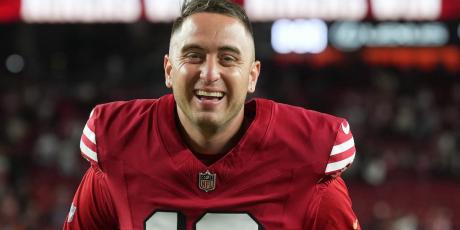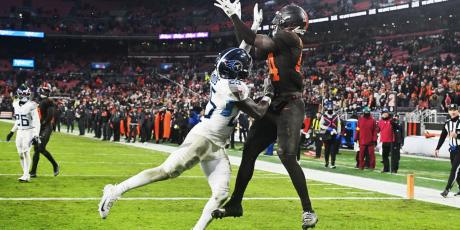When to Draft a Tight End in Your Fantasy Football League

Let’s face it, the TE gets a bad rap. Sure, people care a little bit more about them than kickers or team defense, but the TE is often an afterthought for the general drafting population. Your average fantasy football player doesn’t spend much time evaluating their TE options and will usually either reach for one of the top guys or settle for a passable option somewhere throughout the course of their draft. I’m here to change that stigma, and arm you with a few different strategies to maximize your points at the TE position, allowing for the most bang for your buck on draft day.
Editor's Note: Click here for 2018 TE draft strategy edition.
More 2017 Positional Draft Strategies: QB | WR | Zero RB | Streaming D/ST | IDP | PR & KR
The Opportunity Cost of Drafting a Tight End Early
When constructing your fantasy football rosters, the players that you choose to pass over should have as much of an impact on your decision as those that you eventually select. This theory is referred to as opportunity cost, and should be taken into consideration when deciding when to grab a TE, especially in the earlier rounds of your draft.
In a standard 12-team league, starting rosters consist of two RBs, three WRs, one TE and one flex comprised of usually a RB, WR and maybe a TE. Because you must start multiple other positional players versus just the one TE, the demand for these players is much higher. An average league has to roster anywhere from 24-48 positional players depending on league rules for the flex position. This creates a deficiency in the supply for RBs and to a lesser extent WRs that does not meet the league’s demand. This in turn results in somewhat of a surplus on TEs, as there is at least one starter on every NFL team so there is always an availability, even after fantasy drafts and into the season.
If you are sitting at the lower end of the draft order, say picks 10-12, and are debating whether to grab the top TE off the board, it may help the decision process to glance back at some previous drafts to determine whether the production from that TE was worth his draft spot over a similar positional player. It wasn’t that long ago when TEs were not even remotely considered draftable until around the third or fourth round.
In 2014, we saw Jimmy Graham, then with the New Orleans Saints, crack the first round with his ADP at 1.08. He finished that season with 889 yards and 10 touchdowns. Players who were available around him include Dez Bryant (1,320 yards, 16 touchdowns), and DeMarco Murray, (1,845 yards, 13 touchdowns). It would have proven more beneficial in this case, to have gone with the WR or RB and waited until later rounds for your TE, as Rob Gronkowski who had an ADP of 3.06, ended the season with 1,124 yards and 12 touchdowns. In 2015, Gronk was a clear first round draft pick across the board and folks who drafted him got points for 1,176 yards and 11 touchdowns. WRs that were selected around him include Odell Beckham Jr., (1,450 yards, 13 touchdowns) and Calvin Johnson (1,214 yards, nine touchdowns).
Conversely, two RBs with similar ADPs that year were C.J. Anderson (720 yards, five touchdowns) and Matt Forte (898 yards, four touchdowns). In this instance, you were better off grabbing Gronk or one of the WRs than going with a running back in the tail end of the draft order. That season saw much better production from TEs in later rounds from players such as Delanie Walker (1,088 yards, six touchdowns) in the ninth round or even Jordan Reed in the 15th (952 yards, 11 touchdowns).
In 2016, the trend was to lay off the TE position in round one, with Gronk’s ADP hovering around pick 15, or 2.03. Sadly for his drafters, the Patriots TE only played in seven games, finishing with 540 yards and three touchdowns, as TE26 in fantasy points. In an injury-riddled year all around, the guy drafted right before him was WR Keenan Allen, who went down Week 1 with a torn ACL, never to return to the field all season. Mike Evans had an ADP of 2.04, and flourished in 2016, ending as WR3 with 1,321 yards and 12 touchdowns. The two closest RBs to Gronk when it comes to 2016 ADP, were LeVeon Bell and Devonta Freeman, who both ended the season with more than double his yardage and touchdowns. You were much better off waiting until round six to grab a TE in 2016, as both Travis Kelce and Delanie Walker finished among the top five in fantasy points.
Opportunity cost varies from year to year and of course hindsight is always 20/20. All we can do is provide you with the information and tools -- it is up to you to determine what suits your specific draft needs.
Targeting a Late-Round Tight End with Upside
This approach is for those who feel that the top tier of TEs were drafted too early, and are looking for guys who could get the same production at a much lower draft position. If your fellow league mates selected their TE in the first few rounds, they will be less likely to draft another in those middle to late rounds leaving great value on the board.
Upside can be found via several different avenues, the first of which is a TE that is projected a high volume of red zone targets for his team’s offense. In 2016, Cameron Brate provided an excellent example as he was widely undrafted and targeted in the red zone 19 times, the same as teammate Mike Evans and more than the combined total targets of Bucs’ WRs Adam Humphries and Russell Shepard. That same season, Kyle Rudolph had a 16th or later round ADP and led all TEs in red zone targets with 30, along with a whopping 53.33 completion percentage inside the 20.
According to research done by 4for4’s own TJ Hernandez in his historical year-to-year predictability piece, in PPR scoring, fantasy points seems to correlate stronger for the TE from one year to the next than the other position players. This helps us track upside for lower ranked TEs based on previous year’s performances and pluck out guys that we think will be a solid value at their ADP. Jason Witten is someone who we keep anticipating a downslide, however year after year, he continues to produce above expectations. In 2016, Witten was the 16th TE taken off the board, drafted with a 13th round ADP. The Cowboys TE ended the season with 152.3 fantasy points, ahead of players taken before him such as Coby Fleener, Dwayne Allen and Julius Thomas. As mentioned above, Kyle Rudolph is another TE with a ton of upside. In 2016, he was barely drafted, or taken in round 16, and finished out the year as the TE2 in PPR fantasy points, ahead of all TEs not named Travis Kelce.
Another way to determine which later round picks could potentially offer TE1 value is to target players on teams with the most efficient offenses. If that team historically moves the sticks with high frequency, there’s a greater chance for that TE to rack up receiving yards and potentially be targeted in the end zone more often. Going back to 2010, the teams that cracked the top five in offensive efficiency the most were Seattle, New Orleans, Green Bay and Pittsburgh.
If on draft day you find yourself panicking because you missed out on the higher rated TEs and feel that you’re doomed for TE2 production, just think about these trends and feel confident grabbing a later round player who’s oozing with upside.
Drafting with the Aim of Using a Tight End By Committee
Running a specific position by committee is a recent trend in the NFL, but really shouldn’t be used in terms of fantasy football unless you are competing in a very deep league. For a standard 12-team league with 16 rounds, most people only draft one TE with the intention of grabbing a guy off the waiver wire for your player’s bye week or for insurance purposes. Since only 12 or so TEs get drafted, there will certainly be players available down the road who offer plenty of upside so it behooves you to select a WR or RB on draft day, instead of a second TE.
In leagues with deeper benches or more teams vying for valuable TEs, a committee is still risky but could work if you aim for two players with enough upside to potentially reach TE1 status, rather than drafting one or even two players that could prove to be TE2’s. If you do decide to go the committee route, I would suggest utilizing our hot spot tool to evaluate the best players to roll the dice with. It will show you via a color-coded system, the weeks throughout the season where defenses allow the most points to the TE position so that you can plan your committee accordingly.
Streaming Tight Ends as a Last Resort
Some people feel that if they decide not to select an elite TE towards the top of the draft, then they should just grab anyone along the way and play the waiver wire each week, otherwise known as streaming. Whether you believe in drafting TEs early, late or in the middle, our end goal is to always get the most value out of each player at every position.
I wouldn’t suggest going into a draft with the strategy of streaming, however, if your TE selection doesn’t pan out due to injury or some other unforeseen variable, you should be armed with the knowledge of the best way to go about it.
An excellent resource to start with is our Schedule-Adjusted Fantasy Points Allowed, or aFPA. Sortable by position, this tool allows you to go in and see the number of fantasy points allowed to TEs by each NFL team, making the choice between two players for streaming purposes easier from week to week. When going over the aFPA along with the NFL schedule, players I would go after in the draft for early streaming purposes are Jermaine Gresham (ARI), Jared Cook (OAK), and Evan Engram (NYG).
The Cardinals open the 2017 season against the Detroit Lions followed by the Colts the second week, and the Cowboys in Week 3. All three of Gresham’s opponents rank among the 11 worst at defending the TE, with an average aFPA of 15.8 adjusted fantasy points allowed. In Cook’s new home, the Oakland Raiders face soft opponents in their early matchups, with Washington owning the fourth worst TE aFPA and the Colts with a current aFPA of 14.2 to the TE position. Cook is currently projecting an ADP in the 13th round, which presents good value. In New York, the Giants rookie Engram gets Dallas and Detroit in the first two games of the 2017 season, which we already went over as among the worst at defending TEs.
Strength of schedule can be shift wildly early in the season, but history suggests that teams at the extremes tend to stay there.
Utilizing a Tiered System to Rank and Draft Tight Ends
A tiered system might not go over well in some social and economic situations, however in fantasy football, especially at the TE position, approaching the draft knowing which players fall into what tier is extremely valuable. As has been true in the recent past, the TE rankings include one player in the top or elite tier, followed by a few more whose ADP should fall within rounds four through six, and then the remainder of the pack.
The decision to roster this season’s one elite TE, Rob Gronkowski, really depends on your specific draft slot and your approach to roster construction. If your draft location sits within the first three quarters of the pack in a 12-team league, it doesn’t really make sense to draft Gronk, as you will get more value from a top WR or even an elite RB. For example, according to our rankings for standard scoring, there are 13 WRs and 16 RBS projected to score more fantasy points this season than the top TE, or Gronk. As we all know, these are just prognostications and it will be up to you to decide of you want to roster a TE as your first pick, foregoing a top WR or RB.
When it comes to the second tier of TEs, there are three to four players who are worth drafting sometime in the fourth round, depending on your league’s scoring, of course. This tier is comprised of Travis Kelce (KC), Jordan Reed (WASH), and Greg Olsen (CAR), followed by Delanie Walker (TEN) and Jimmy Graham (SEA), who should be considered closer to the sixth round. Whether you jump in and grab one of these TEs, or wait until later in the draft really depends on which strategy of the ones I have gone over so far appeals to you this season.
After the second tier, the rest of the top 12 TEs are interchangeable in 2017, meaning none of them are worth going after until later in the draft. I have no problem waiting until rounds nine or 10 and drafting Kyle Rudolph, Hunter Henry or even Eric Ebron. Some guys who should see a bump from last season who will be available in double-digit rounds are CJ Fiedorowicz and Jack Doyle. Fiedorowicz actually led the Texans in red zone targets in 2016, and proved to be a valuable member of Houston’s receiving corps. Regardless of who’s under center this season, look for the talented TE to pick up right where he left off in 2016, with a super cheap late-round price tag to boot. With Dwayne Allen off to the home of the Super Bowl 51 Champs, Jack Doyle steps in as the Colts TE1, and is projected to have decent numbers, compared to his 14th round draft projection in 2017.
However you decide to approach the TE position this season, be sure to be as prepared as you can be, because fantasy football is all about total points. The championship trophy doesn’t care which position those points actually come from. And remember, TEs need love, too.
Photo by Patrick Smith/Getty Images.
Editor's Note: Subscribe now and get an early-bird discount on 4for4's 2017 Classic, Pro, or DFS products!
Related Articles
- What are the Most Predictable Year-to-Year Stats for Quarterbacks?
- When Should You Draft Your Quarterback?
- How Often do Top-12 PPR Tight Ends and Quarterbacks Repeat in the Following Season?
- When Should You Draft Your Running Back?
- How Often do Top-12 PPR Ru


















